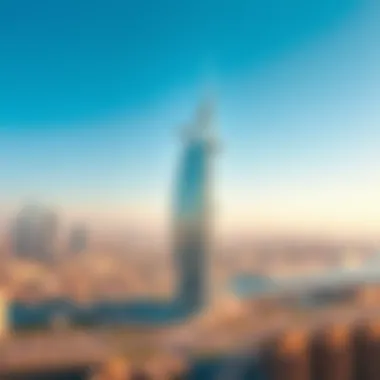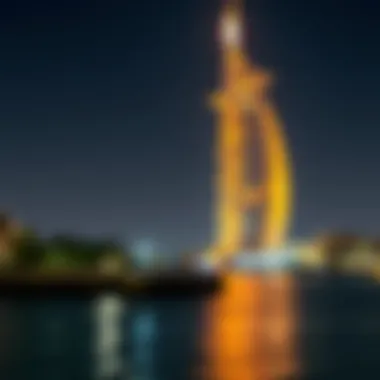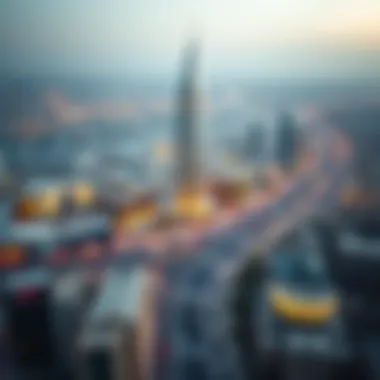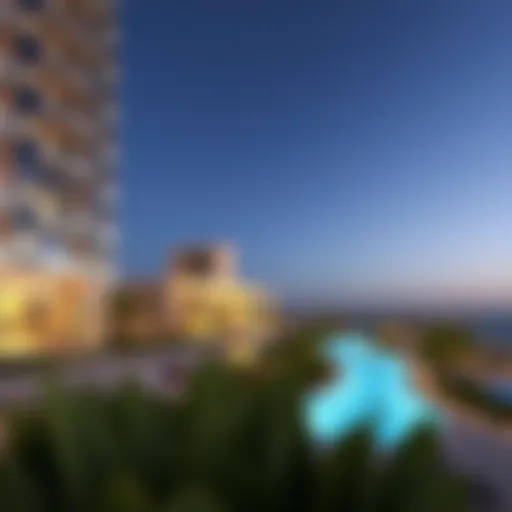برج النخلة: A Comprehensive Look at Dubai's Landmark


Intro
Dubai, a city synonymous with grandeur and architectural brilliance, is home to برج النخلة, a striking skyscraper that defies conventional design norms. This magnificent structure, often described as an emblem of Dubai’s ambition, stands as a testament to the city’s growth and technological prowess in engineering. As urban development increasingly shapes skylines across the globe, برج النخلة represents not just a physical landmark, but a beacon for real estate opportunities and cultural significance in an ever-evolving metropolis.
Understanding the intricacies of برج النخلة goes beyond mere aesthetics. It dives into the core of the emirate's urban planning strategies, real estate dynamics, and economic potential—all of which contribute to its ongoing allure for investors and homebuyers alike.
With emerging neighborhoods sprouting around it and an evolving market landscape, getting a grasp of current trends is crucial. Investors and analysts can significantly benefit from a closer look at the local market, evaluating which areas are ripe for investment and development. Let’s embark on this detailed exploration of برج النخلة, examining its architectural details, urban influence, and the investment potential it holds.
Foreword to برج النخلة
When we think about the skyline of Dubai, one cannot overlook برج النخلة. This towering structure not only defines the city's architectural landscape but also encapsulates its ambitions for growth and innovation. Looking deeper into the topic of برج النخلة illuminates its multifaceted importance for diverse audiences. Whether you're an investor eyeing lucrative opportunities or simply an admirer of architectural achievements, understanding برج النخلة offers a lens into Dubai's dynamic evolution.
Overview of Architectural Significance
The architectural finesse seen in برج النخلة is remarkable. Designed to mimic the shape of a palm tree, the building stands as a testament to the marrying of nature and man-made structures. Creating an identity of its own, it integrates elements that reflect UAE's rich cultural history while pushing the envelope in modern design. The flowing lines and organic contours of the structure challenge the traditional perception of skyscrapers, which are often boxy and rigid.
The geometric intricacies are striking, featuring a series of terraces and gardens that punctuate the facade and contribute to its lush aesthetic. The architect behind the project harnessed both global architectural principles and local design elements to spawn an iconic silhouette that captures both the eye and the heart of onlookers.
"برج النخلة is more than just a building; it represents the vision of a nation aiming for the skies."
Location and Accessibility
Strategically located within the vibrant Dubai Marina district, برج النخلة boasts a central position that attracts both residents and tourists alike. Nestled among a plethora of dining and entertainment options, the skyscraper is ideally placed for a lifestyle that intermingles work and leisure.
Accessibility is king in a city like Dubai, and this skyscraper does not disappoint. It benefits from a well-planned infrastructure that accommodates the needs of its inhabitants and visitors. The proximity to the Dubai Metro and several major road networks simplifies commutes, making it easier to navigate the city.
Residents and patrons of برج النخلة enjoy a lifestyle where convenience is at their fingertips. Not only can they indulge in local amenities, but the astonishing views from the upper floors also offer a panoramic glimpse of the sprawling cityscape and the Arabian Gulf, making it a prime living choice.
Design Features of برج النخلة
The design features of برج النخلة hold significant importance when analyzing this architectural wonder. They not only shape the aesthetic appeal but also dictate how this towering structure interacts with its environment. Understanding these aspects is crucial for investors, architects, and urban planners, as they highlight the innovations that make برج النخلة stand out in Dubai's ever-evolving skyline.
Architectural Style and Inspiration
The architectural style of برج النخلة can be characterized as a modern interpretation of traditional forms, infused with a futuristic vision. It draws inspiration from the palm tree, a symbol of both sustenance and beauty in the Arabian culture. This organic design is not merely about looks; it expands on the idea of growth and prosperity, resonating well with both residents and tourists.
The curved lines of the structure mimic the fronds of a palm, giving it a fluid, natural feel. Such elements create a striking profile against Dubai’s stark skyline, commanding attention from far and wide. Additionally, the use of glass facades reflects the sun's light, enhancing energy efficiency and blending the building seamlessly with its airy surroundings.
Going beyond aesthetics, the design serves practical purposes too. It promotes airflow around the structure, reducing the need for artificial cooling and making it more livable.
Materials and Construction Techniques
When discussing the materials and construction techniques used in برج النخلة, one must appreciate the cutting-edge approach embraced during its development. The building uses reinforced concrete, ensuring durability and resilience against the often harsh weather conditions in Dubai.


Moreover, the incorporation of high-performance glass not only provides stunning views but also contributes to energy efficiency, reducing reliance on heating and cooling systems. This careful selection of materials aligns with Dubai's broader goals of sustainable urban development.
The construction techniques employed involved a mix of traditional craftsmanship and modern engineering. With modular construction elements, the project was completed more efficiently than many comparable skyscrapers. This innovative approach allowed for quicker assembly without compromising the structural integrity or design elegance.
Sustainability Features
Sustainability is at the heart of برج النخلة, which is evident in several of its key design features. The building employs a variety of green technologies to minimize its environmental footprint while enhancing the quality of life for its inhabitants.
One standout feature is its rainwater harvesting system, which collects and recycles water for landscaping and other non-potable uses, thereby reducing dependency on municipal water supplies. There's also a prominent focus on energy efficiency, with solar panels integrated into the design to harness Dubai's abundant sunlight.
The surrounding landscape was meticulously designed to integrate native flora, which supports local wildlife and requires less maintenance and irrigation. By promoting biodiversity, برج النخلة serves not just as a residence or landmark, but as a model for sustainability in urban architecture.
"Sustainable design is not just about how buildings look; it’s about how they function within their ecosystem."
In summary, the design features of برج النخلة highlight a harmonious blend of aesthetic appeal, innovation, and sustainability. As such, they present a compelling case for those looking to invest in Dubai's real estate market, with potential for both financial returns and a positive impact on the community.
Historical Context
Understanding the historical context of برج النخلة is not just about dates and directives; it paints a detailed picture of Dubai’s evolution into a global metropolis. This iconic structure stands as a testament to the city’s rapid transformation and ambition. By examining its timeline of construction and the influence of cultural heritage, we glean insights into both the architectural and societal narratives that have shaped Dubai today. These historical elements are vital for investors, analysts, and homeowners alike, as they reflect the region's potential for growth and development.
Timeline of Construction
The project to construct برج النخلة began in the early 2000s, a period marked by a surge in development throughout Dubai. Here’s a closer look at significant milestones:
- 2004: Groundbreaking commenced, marking the initial steps in realizing this architectural vision.
- 2007: The first major phase of construction was completed, with the structure rising noticeably above the cityscape.
- 2010: Work slowed due to financial adjustments in the global economy, yet the project persevered, showcasing resilience among investors.
- 2016: Final touches and internal fittings were completed, leading to the highly anticipated opening.
This timeline illustrates not only the dedication towards completing برج النخلة, but it also reflects the broader economic currents affecting Dubai. Investors should note how the challenges of the construction phase laid down a resilient foundation for future endeavors in the area.
Influence of Cultural Heritage
The architectural design and function of برج النخلة are steeped in cultural significance, marrying modern aesthetics with traditional values. Here are a few ways in which cultural heritage has influenced its development:
- Design Elements: The intricate patterns often seen in Arabic architecture are prominent throughout the building, incorporating elements that reflect the region's historical styles.
- Community Engagement: Local artisans and craftsmen were involved in various aspects of the construction, ensuring that the building honors Emirati culture while also pushing modern boundaries.
- Symbol of Identity: For many, برج النخلة represents more than just a building; it embodies the unity of tradition and progress, showing how a vibrant culture can thrive in the face of modernization.
In drawing connections between برج النخلة and its cultural roots, investors can understand the deeper implications of their investments—this is a site of community pride and a focal point for tourism.
"The melding of historical and modern elements not only beautifies the skyline but weaves a rich tapestry of Dubai's identity" — a phrase that resonates when considering the impact of cultural heritage.
As such, awareness of these historical contexts is crucial for all stakeholders, allowing for informed decisions based on a holistic understanding of the environment surrounding the برج النخلة.
Real Estate Impact
The real estate impact of برج النخلة is a focal point of this analysis, highlighting its profound influence on Dubai's architectural landscape and property market dynamics. The presence of such a landmark not only elevates the prestige of the area but also acts as a catalyst for various economic activities linked to real estate. Understanding the nuances of these impacts can equip investors, property managers, and stakeholders in navigating this bustling market more efficiently.
Market Trends Associated with برج النخلة


When looking at the market trends linked to برج النخلة, one can't ignore the way it has influenced property demand nearby. The iconic structure has become a focal point for luxury developments, which attracts both domestic and international interest. As it stands tall, like a beacon of modernity, it signals to potential buyers and investors that the area is both thriving and desirable.
- Increased Demand: Properties in close proximity to برج النخلة often see heightened demand due to the prestige associated with the presidential landmark. Buyers are drawn to the area's beauty and modern amenities.
- Price Stabilization: The presence of برج النخلة has been known to stabilize property prices in the vicinity. Investors may find that even during market fluctuations, demand remains consistent due to the allure of residing near a globally recognized structure.
- Enhanced Lifestyle Appeal: With luxury shopping, dining, and entertainment options sprouting around the skyscraper, market growth follows. These trends create a holistic environment that appeals to families, expatriates, and investors alike.
Investment Opportunities
Investing in properties near برج النخلة presents numerous opportunities, attracting both seasoned investors and newcomers seeking growth. The strategic positioning of this skyscraper has paved the way for diverse investment options.
- High-end Real Estate: Luxury condominiums and villas are emerging as prime investments. As new developments sprout up, returning value becomes a considerable advantage for investors.
- Commercial Real Estate: Businesses are flocking to the area to capitalize on the tourist influx. Opportunities in office spaces or retail units cater to a variety of enterprises looking for visibility and impact.
- Short-term Rentals: The tourist magnet effect of برج النخلة makes it an attractive zone for short-term rentals, offering lucrative returns for investors who wish to enter the hospitality market.
Rental Market Overview
The rental market surrounding برج النخلة has seen notable transformation due to its prominence. Landlords and property managers must keep a finger on the pulse as the landscape continues to evolve.
- Rental Increases: As interest surges, rental prices within the vicinity have likewise escalated, reflecting the skyscraper’s desirability. Investors should be aware of these trends to make informed decisions.
- Diverse Tenant Base: The mix of locals and expatriates creates a dynamic tenant ecosystem. This variety ensures lower vacancy rates, providing landlords with consistent income.
- Amenities and Services: Properties near برج النخلة often come equipped with luxury amenities which further entice potential tenants. Access to quality schools, hospitals, and recreational facilities adds to the appeal.
Overall, the impact of برج النخ�لة on the real estate market is a multifaceted phenomenon. It serves not merely as a physical structure but as a vital component of Dubai's urban identity. Investors, agents, and buyers alike must keep abreast of these trends to capitalize on the opportunities this landmark presents.
Tourism and Cultural Relevance
The intertwining of tourism and cultural significance within the context of برج النخلة encapsulates the very essence of Dubai’s vibrant identity. As the city continues to evolve, برج النخلة stands not merely as a symbol of architectural ambition, but as a nexus fostering economic vitality through tourism. Tourists from around the globe flock to see its splendor, underscoring the skyscraper’s role in enriching Dubai’s cultural landscape.
Attraction for Tourists
The attraction of برج النخلة to tourists cannot be understated. This is a destination where luxury meets cultural resonance, offering visitors an opportunity to experience Dubai’s amazing skyline from an iconic viewpoint. The features that capture visitors’ hearts include:
- Stunning Views: The observation decks provide breathtaking panoramas of the Dubai coastline and the surrounding metropolises. This vista not only serves as a backdrop for memorable photos but also encapsulates the rapid growth of this desert marvel.
- Architectural Tours: Guided tours frequently take place, allowing guests to dive into the intricacies of its design and the ambitious vision behind its construction. These tours often explore details that might otherwise be overlooked, such as the symbolism in its palm tree-inspired structure.
- Culinary Experiences: Various dining options within or near برج النخلة attract food enthusiasts. Visitors can indulge in culinary delights influenced by both local and international cuisines, often set against the backdrop of the city’s twinkling lights.
- Shopping and Entertainment: This area, often teamed with luxurious shopping malls and entertainment hubs, ensures that tourists find more than just a visual feast. Entertainment options range from art galleries showcasing local talent to live performances that celebrate the rich tapestry of Emirati culture.
The climb only gets steeper when accounting for برج النخلة’s potential to enhance Dubai’s tourism sector further, as its admiration grows exponentially compared to other attractions. The very presence of برج النخلة reshapes the skyline into a dynamic experience that beckons tourists time and again.
Cultural Events and Activities
Cultural events hosted in and around برج النخلة enhance its position as more than just another skyscraper. These activities foster a sense of community and promote local traditions, engaging both residents and tourists alike. Significant aspects include:
- Festivals: Annual festivals often take place within view of برج النخلة, such as the Dubai Shopping Festival and the Dubai International Film Festival. These events turn into grand occasions, drawing international crowds, showcasing movies, art, fashion, and, indeed the luxurious lifestyle of the UAE.
- Art Exhibitions: With a focus on artistic expression, various exhibitions frequently feature local and international artists, celebrating not only contemporary art but also traditional forms. This engagement with the art world enriches the cultural fabric of Dubai, while simultaneously elevating the status of برج النخلة as a cultural hub.
- Cultural Workshops: Workshops that focus on Emirati traditions, such as calligraphy and pottery, are often organized at or nearby this architectural marvel. These sessions offer hands-on experiences, allowing tourists to delve deeper into the heritage of the region.
The dual role of برج النخلة in tourism and culture is essential for its significance. This skyscraper has become a literal and figurative stand it in the heart of Dubai, contributing to the narrative of a city that continues to redefine itself while remaining rooted in its rich history. As wind of future developments stream in, the cultural relevance of برج النخلة will likely skyrocket, enticing a growing number of visitors eager to partake in this extraordinary journey.
"Bringing different cultures together under one roof, برج النخلة stands as a symbol of unity and splendor in the ever-evolving landscape of Dubai."
Future Prospects of برج النخلة
The future prospects of برج النخلة represent not only a beacon of architectural excellence but also a reflection of Dubai’s ever-evolving real estate landscape. This section seeks to explore the developments on the horizon, emphasizing how both planned projects and urban trends could significantly affect the longer-term viability and allure of the property.


Planned Developments Around برج النخلة
In the immediate vicinity of برج النخلة, several ambitious developments are in various stages of planning and execution. These projects are poised to reshape the area, enhancing its value and attractiveness. Key highlights include:
- Extension of Public Transportation: The introduction of new metro lines and tram services will boost accessibility, encouraging foot traffic and enhancing the general appeal of the location. This can serve as a magnet for potential tenants and investors.
- Mixed-use Developments: Projects such as Dubai Marina expansion are being conceptualized to provide a blend of residential, commercial, and leisure spaces. Such integrations could significantly enhance the vibrancy of the area surrounding برج النخلة, making it a hotspot for both locals and tourists.
- Cultural and Recreational Spaces: Plans are underway to establish parks, art installations, and community centers nearby. These initiatives would not only enrich the local culture but could also attract families looking for a community feel within a bustling urban setting.
The overall development strategy aims to create a cohesive environment where residents and visitors alike can enjoy a well-rounded lifestyle, thus increasing interest in properties like برج النخلة.
Impact of Urbanization on Property Value
Urbanization is a double-edged sword when it comes to property values. On one hand, increasing buildings and amenities can elevate land value; on the other, the potential for overdevelopment could lead to market saturation. Despite this, several factors suggest that برج النخلة will likely benefit from ongoing urbanization:
- Increased Demand for Luxury Living: As Dubai continues to attract a diverse array of residents, the demand for high-end, well-designed spaces remains robust. برج النخلة caters specifically to this growing demographic, offering luxury and access that is unmatched.
- Infrastructure Improvements: With the ongoing urban developments, infrastructure in Dubai is becoming more sophisticated and interconnected. For instance, improved road networks and transportation hubs enhance accessibility, naturally driving up property demand in nearby areas.
- Investment in Technology and Sustainability: As urban centers adapt to modern technological and ecological demands, properties that incorporate smart technology and sustainable practices will find themselves at a premium. برج النخلة’s focus on eco-friendliness aligns well with these trends.
"The architectural vision behind برج النخلة not only aims for aesthetic appeal, but also seeks to enhance the living experience for its occupants, making it a cornerstone of Dubai’s future urban landscape."
Community and Social Aspects
Understanding the community and social dynamics surrounding برج النخلة is essential to appreciate the broader impact this skyscraper has made in Dubai. The interactions between its residents, and the availability of social infrastructure create a unique living environment. As an iconic structure, it serves not just as a landmark but as a catalyst for community development.
Residential Composition of the Area
The residential makeup around برج النخلة is diverse, reflecting the cosmopolitan character of Dubai. Predominantly, the area attracts expatriates from various nationalities seeking a vibrant urban lifestyle combined with luxury living.
- Types of Residences: High-rise apartments, luxury condominiums, and townhouses are scattered throughout. Many dwellers opt for modern, spacious units with breathtaking views of the Arabian Gulf. The demand for such residences is consistently high due to the skyline's distinct appeal that برج النخلة contributes to.
- Population Demographics: Families, young professionals, and retirees inhabit the vicinity, bringing different needs and preferences. This demographic mix fosters a lively community atmosphere. Residents benefit from a blend of cultural influences that enrich social interactions.
- Community Engagement: Numerous social clubs, resident associations, and community events engage the local population. This participation promotes connections among neighbors, enhancing the sense of belonging.
Local Amenities and Facilities
The local amenities serving the residents around برج النخلة play a significant role in community life. They include everything from leisure activities to essential services, all contributing to a comfortable lifestyle.
- Recreational Facilities: Parks, fitness centers, and swimming pools are easily accessible. They encourage outdoor activities and social gatherings, allowing residents to unwind and meet one another.
- Educational Services: Schools and childcare centers are conveniently located. Many international schools cater to the diverse population, offering various curricula. This is a significant consideration for families moving into the area.
- Healthcare Institutions: Proximity to quality healthcare facilities provides peace of mind. Clinics and hospitals ensure that residents have easy access to medical services, a critical factor for potential residents and investors alike.
- Shopping and Dining Options: Shopping malls, local markets, and a range of restaurants enhance the area's livability. A mix of luxury brands and local shops provides variety, while dining options cater to all tastes.
- Transport Accessibility: Efficient public transport systems increase connectivity. The area is well-served by buses and the metro, making commuting easier for residents. This accessibility is a significant draw for those considering living in proximity to برج النخلة.
In summary, the community surrounding برج النخلة is characterized by its diverse residential composition and robust local amenities, which together foster a vibrant and supportive living environment. Whether it's the convenience of shopping or the joy of community engagement, these aspects contribute to making the area an attractive place to live.
Closure
The conclusion of this article highlights the salient points discussed regarding برج النخلة and its pivotal role in Dubai's architectural landscape. One can't overlook how this skyscraper functions not just as a physical structure but as a symbol of ambition and innovation. What stands out is the memorable impact it exerts on various fronts: architectural significance, the local economy, and social dynamics in the community.
Summary of Key Findings
The exploration of برج النخلة has revealed several noteworthy elements:
- Architectural Marvel: The unique design features combine modern aesthetics with cultural elements, reflecting both global and local architectural trends.
- Urban Impact: Its presence has transformed the skyline and contributed effectively to urban development, showcasing what a contemporary skyscraper can inspire in a bustling city.
- Economic Viability: Factors such as rising property values and increased tourism have positioned برج النخلة as an attractive proposition for both investors and residents. The surrounding amenities further enhance its appeal, making it a desirable location.
- Cultural Relevance: Incorporating elements of Dubai’s rich heritage, برج النخلة serves not only as a landmark but as a gathering place, enhancing the cultural fabric of the community.
“As Dubai continues to evolve, برج النخلة stands as a testament to what architectural ingenuity can achieve in the modern age.”
Final Thoughts on the Significance of برج النخلة
Reflecting on برج النخلة, it's clear that its significance transcends mere aesthetics. This skyscraper embodies the very essence of Dubai’s meteoric rise as a global hub. For investors, agents, and homebuyers alike, the implications are profound. Potential growth means more than just real estate; it encompasses lifestyle, community, and investment security. The blend of luxury living and cultural richness signifies that برج النخلة is more than a building—it's a community statement that defines modern living in Dubai. As urban trends push forward, it will be curious to observe how برج النخلة adapts and thrives in the face of future developments.
In summary, برج النخلة is not merely an iconic structure. It stands as a metaphor for Dubai's ambition and a beacon for future urbanization, making it essential for those interested in the region's real estate landscape.







